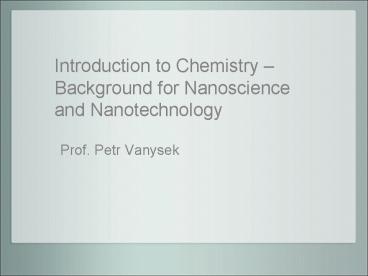Introduction to Chemistry - PowerPoint PPT Presentation
1 / 22
Title:
Introduction to Chemistry
Description:
The number of covalent bonds an atom is likely to form is determined by its ... of one molecule and an electron pair or electronegative atom of another molecule. ... – PowerPoint PPT presentation
Number of Views:56
Avg rating:3.0/5.0
Title: Introduction to Chemistry
1
Introduction to Chemistry Background for
Nanoscience and Nanotechnology
- Prof. Petr Vanysek
2
Introduction to ChemistryCompounds
3
(No Transcript)
4
(No Transcript)
5
Chemical Bonding
- Covalent bonds
- Ionic bonds
- Metal bonding
6
Covalent bonds
- Covalent bonding is when electrons are shared
between to atoms or more. - The number of covalent bonds an atom is likely to
form is determined by its place in the periodic
table and the number of valence electrons it has. - An atom will share electrons with another atom so
that it results in them both having a full
valence shell. Usually this will be 8 electrons.
7
Ionic bonds
- When a metal and a non-metal form bonds they are
typically ionic bonds where electrons are
transferred from the metal to the non-metal. - Some metals will lose enough electrons to achieve
a complete valence shell. - Non-metals will usually gain enough electrons to
achieve a complete valence shell. - Many metals are able to form ions with more than
one charge.
8
Metal bonding
- In metals the atoms are held together by metal
bonding. Electrons can easily transfer from one
atom to the next. This suggests a model of
positive ions in a sea of electrons. Metals can
conduct electricity because electrons flow easily
in any direction.
9
Covalent and Ionic Bonding
Atom of Covalent Bonds Typical charge for an Ion
H 1 1
C 4
O 2 -2
N 3
F, Cl, Br, I 1 -1
S 2 -2
Si 4
Li, Na, K 1
Be, Mg, Ca, Sr, Ba 2
10
Polar Molecules
- Polar Molecules
- If the electron density is not distributed evenly
around a molecule then they are polar.
11
Intermolecular BondingBonding between
moleculesvan der Waals forces
- Hydrogen bonding
- This relatively strong type of inter-molecular
bonding which typically occurs between a hydrogen
atom of one molecule and an electron pair or
electronegative atom of another molecule. - Multiple hydrogen bonds hold the DNA double helix
together. - Dipole interaction
- London forces
- These are induced forces caused by a temporary
rearrangement of the electron clouds when
molecules bump together.
12
Hydrogen Bonding
-
-
H
13
Hydrogen Bonding
14
Dipole Interaction
- http//www.chemguide.co.uk/atoms/bonding/vdw.html
- The partial positive and negative ends of the
molecules hold the molecules together.
15
London Forces
London forces are induced dipoles caused by
temporary rearrangement of the electron cloud.
Two hexane molecules approach.
The hexane molecules bump into each other.
The electron clouds rearrange to form a temporary
dipole.
-
-
-
-
-
-
16
Polymers
- Polymers are large chainlike molecules that are
built from smaller molecules called monomers. - For example polyethylene is formed from ethylene
- Proteins are natural polymers.
- http//www.pslc.ws/macrog.htm
17
Chemical Reactions
- Involve the making or breaking of chemical bonds.
- Chemical reactions result in making a new
substance with different properties from the
original substance.
18
Structure of Materials
19
Biological Organization
Organelles
Proteins
Nucleic Acids
Membranes
20
(No Transcript)
21
(No Transcript)
22
Review of Chemistry
- States of Matter
- Atoms, Molecules and Ions
- Subatomic particles
- Periodic Table
- Covalent and ionic bonding
- Chemical reactions
- Intra-molecular forces
- Polymers































